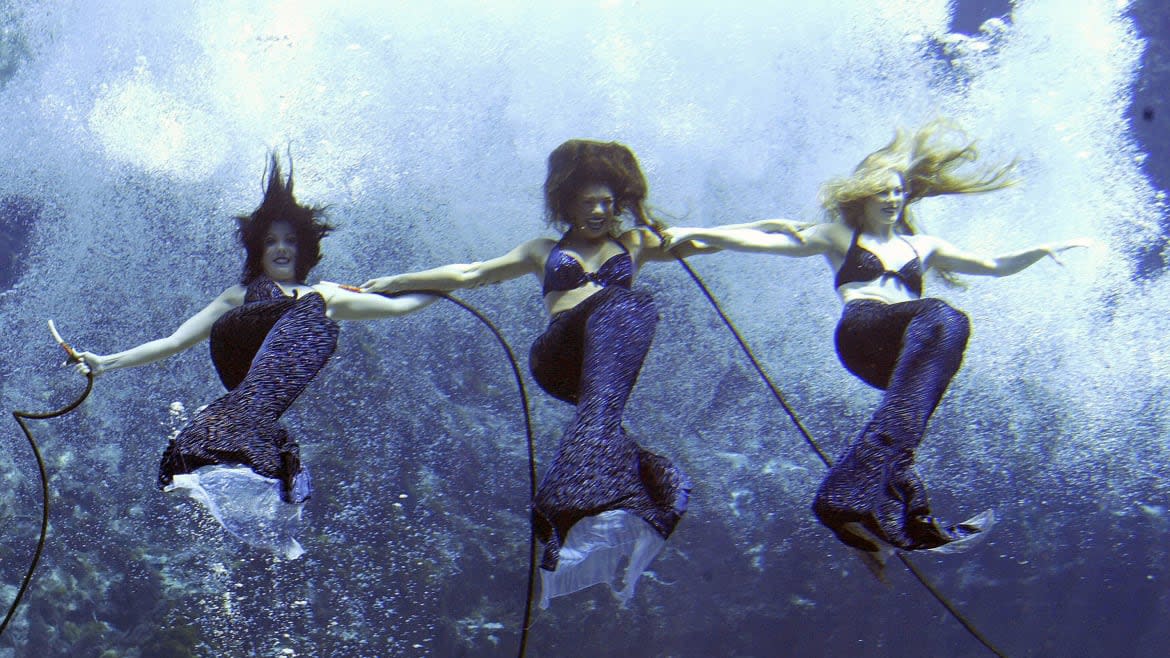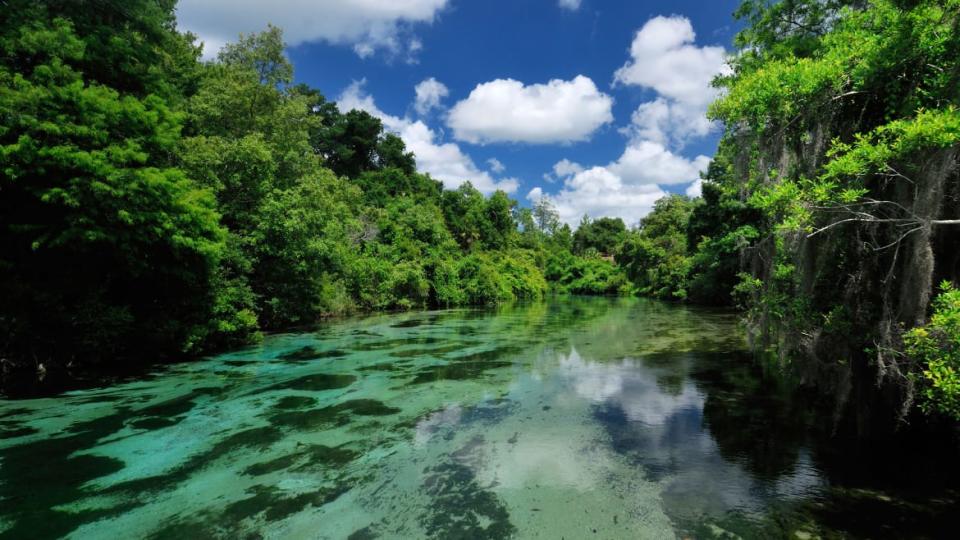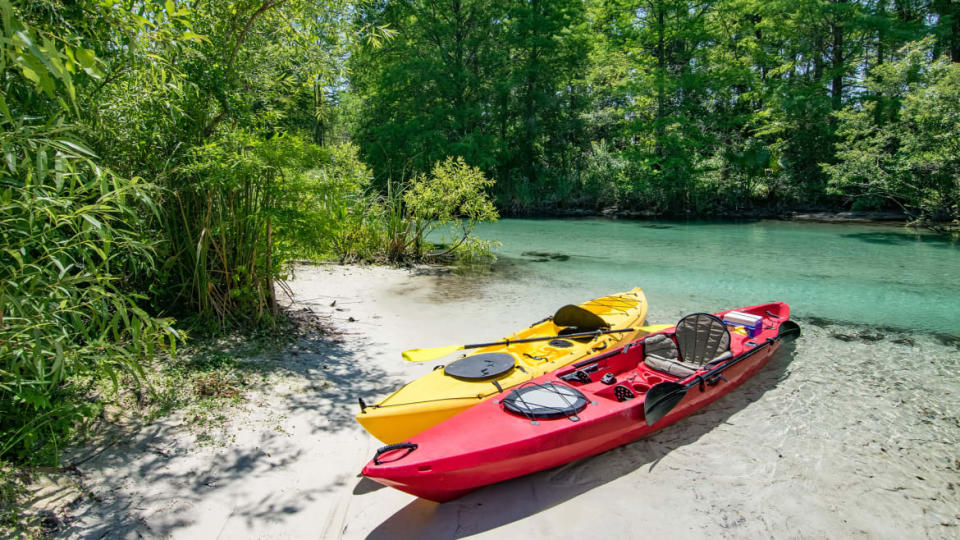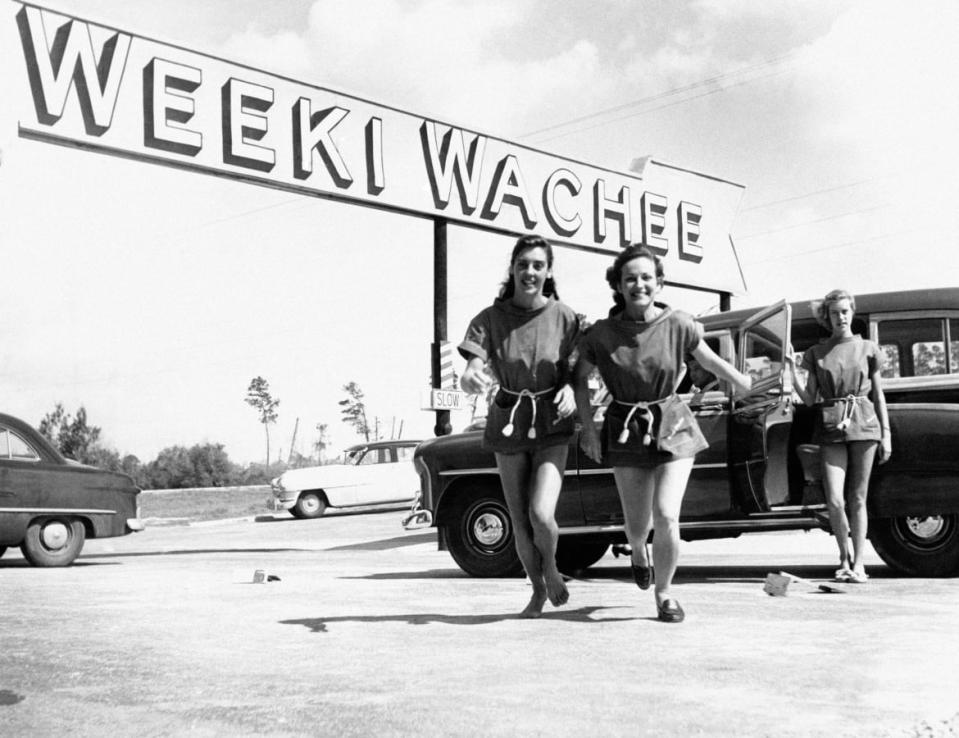Burping Southern Rockers, Itchy Manatees, and Turquoise Water: Cruising the Weeki Wachee River in Old Florida

“Uuuuuuurp”
Startled, I almost pitch the kayak.
“I been waitin’ on that one,” intones a deep voice into a microphone, confirming that, yes, in fact, that had been a burp disrupting my peaceful drift down the turquoise Weeki Wachee River.
“Testing, one-two, one-two,” he continues, and then, plangent opening chords of that funky Southern soul sound drift up the river.
Just as the burping man and his two companions come into view, their warm-up gets into full swing, so my partner and I pull into a bend in the river, beach the kayak, and just lay back and listen.

The river, which begins in Weeki Wachee at its famed spring, runs a dozen miles before emptying out into the Gulf. The river is one of the Tampa/St. Petersburg area’s best attractions, and one of the more unforgettable “Old Florida” experiences around. (“Old Florida” means different things to different people. To me it means pre-Disney, pre-glass towers, and pre-urban sprawl.)
But drifting downstream on an overcast day in winter, I found something I never thought I’d find in this corner of the world—tranquility.
Ecclesiastes declares that “To every thing there is a season, and a time to every purpose under the heaven.” I firmly believe that also applies to kitsch, and nowhere is the time for kitsch more appropriate than a roadside attraction in Central Florida.
We had come to the river to escape family we were visiting in Tampa, get some exercise, and maybe play with a manatee. It was our second visit to the river. The year before we had gone to its origins at Weeki Wachee Springs for the famed Mermaid Show, where local swimmers perform a version of The Little Mermaid underwater, and where I made the mistake of eating an edible before the show, which involves being in a dark theater with hundreds of children and their parents as teenagers twist and turn in dance numbers underwater before you.
Wandering the grounds of the mermaid show and the surrounding area, I could still see vestiges of what made Florida’s natural springs one of the 19th century’s biggest tourist destinations. Long before its coastal sands and sea breezes triggered an unprecedented real estate build-up, Florida’s interior attracted thousands of visitors. The turquoise and aquamarine ponds dotting the state’s jungles were created in the state’s underlying limestone aquifer over thousands of years. They’re fed and replenished by rainwater that works its way through the vast, permeable rock.

Archaeological evidence tells us that many Native American communities sprang up around these springs, which provided both freshwater and abundant game. In the latter half of the 19th century, steamboats traveling the Ocklawaha River to Silver Springs near Ocala or along the St. John’s River drew Harriet Beecher Stowe, Winslow Homer, Thomas Edison, and others. Silver Springs in particular became famous once gilded age skippers began offering tours with glass-bottom boats. As one 19th century New York Times writer noted, “Jacksonville and St. Augustine are only stopping places to the real Florida,” which could be found in the interior where “the oranges grow, the alligators live, the springs flow, the rivers rise.”
After the Florida real-estate boom of the 1920s (described by Jack E. Davis in his Pulitzer Prize-winning The Gulf as “1848 and the California gold rush all over again, or 1897 and the Alaskan Klondike. Except gold wasn’t the hot commodity. Real estate was—the hottest in the country”), a lot of Florida’s interior got carved up for roads, even as its pristine coasts were gobbled up for housing developments and hotels. Even its famously clear and game-filled springs were worn down by the advances of the 20th century: By the time Newton Perry, a former Navy sailor turned Florida entrepreneur, came across Weeki Wachee Springs in 1946, it had been turned into an aquatic junkyard filled with abandoned cars and refrigerators.
Florida and its 20th century culture is measured, much like history with the birth of Christ, in before and after Disney. After Walt Disney transformed central Florida into a mega-destination for the entire world in 1971, the kooky attractions—the sunken gardens, serpentariums, parrot shows, and gator wrestling mudholes—lining the state’s roads quickly began to lose their customers. After all, as the great Blair Waldorf once said, “once men have tasted caviar, it baffles me how they can settle for catfish.” But a few of those odd attractions did survive, and none is perhaps as memorable or kooky as what Newton Perry created in Weeki Wachee Springs.
A prodigious swimmer and inventive entrepreneur, Perry created an underwater mermaid show using air hoses flowing from an air compressor and trained pretty local girls to perform underwater acrobatics and ballet and stunts like drinking Grapette while submerged. He also sank an 18-seat theater into the limestone of the spring so theatergoers could view the show and the spring’s beautiful water and marine life through a giant glass wall. (Old images of performers surrounded by fish and the occasional sea turtle are heartbreaking today, because you know you’ll never see anything like that again.) In 1959, the theater was bought by ABC, and the whole operation was juiced up with a 400-person theater, which still sits there. Promotion went into overdrive, and celebrities like Elvis, Howard Hughes, and Esther Williams stopped by. “Nearly half a million tourists trekked to Weeki Wachee in the late 1970s” notes Lu Vickers and Sara Dionne’s Weeki Wachee, City of Mermaids : A History of One of Florida's Oldest Roadside Attractions.

Eventually the mermaid performance shifted to the current production, which is their own version of Hans Christian Andersen’s The Little Mermaid. While a natural outgrowth of their decades of mermaid-related fare, it’s an ironic choice given the way that Disney irrevocably altered popular understanding of the story. As the property and performers changed hands over the decades, nothing, the book notes, “neither new owners nor old mermaids—could compete against the leviathan Walt Disney World.”
But there was another obvious, albeit more complicated, villain.
“Beginning in the 1970s, developers, too, discovered the magic of the once pristine springs and hinterland,” the authors write. “Spring Hill, a massive Mackle Brothers development, became a Hernando County resident. Algae blooms and traffic jams followed.”
And so while we enjoyed the trippy show, it being right off the highway near massive developments and just after a drive from the sprawl of Tampa-St. Pete (weird observation: Panera still seems to be going very strong down here), it just didn’t give us all the feels we’d been hoping for.
But kayaking upriver from the other end of the Weeki Wachee River the following year, we found exactly what we’d been looking for all along. On our left were ramshackle houses, each different and fascinating. Some had boat garages, some were in disrepair, and plenty had decorations and yard signs that were just so, well, Florida. They also reflected the idea that the political spectrum is really a circle, and that if you go far enough on the right you just end up at the far left. Houses sporting gun-rights signs were neighbors with those with signs about saving the manatees and climate change. And for most of the journey, to our right was the overgrown, swampy, and undeveloped Florida jungle.
Our decision to work our way upriver from The Kayak Shack on the Weeki Wachee river was made for the reward of floating downriver after the workout of going as far as we could. But the real reward, as cheesy as it sounds, were the manatees.
Oh my god, the manatees!
Those bulbous, oddly shaped creatures that somehow pull hard on the heartstrings roam up and down the river and gather in random pockets where the water is deep. If you go early enough, you can often just sit in one of those pockets, watching them loll about all by yourself. But as the day wears on, crowds on paddleboards, canoes, and kayaks will gather. And inevitably, the interactions with these mild creatures will begin in full force.
As you sit in your kayak, they loom right up (and good Lord the bull was huge). They snort, and often the spray will hit you, then they slowly rotate and plunge back down, their wide backs curving and breaking the surface, followed by a little flick of their tail.
While a part of me was pretty sure we weren’t supposed to, we also got off our kayak and waded in the shallows as the curious calf seemed to enjoy the attention from humans, and kept rubbing against people and coming back for rubs. (A woman there who said she was a marine scientist and was doing it was enough for my do-gooder self, who really just wanted to be best friends with the manatees.)
What do they feel like you ask? Squishy and slimy. Almost like a glabrous stress ball or yoga mat.
But one thing certainly stuck with me more than anything else. The scars. Criss-crossed across nearly all their backs were white lines from the propellers of motor boats. It was nearly enough for me to go ask that homeowner if they had any spare “Save the Manatees” T-shirts.
And so as we rounded the bend after playing with the manatees, and saw the trio of middle-aged men—the lead singer tall and wiry with a Ben Franklin hairdo—jamming in the open space under their house on stilts, I knew we had struck gold. Old Florida gold.
Get our top stories in your inbox every day. Sign up now!
Daily Beast Membership: Beast Inside goes deeper on the stories that matter to you. Learn more.

